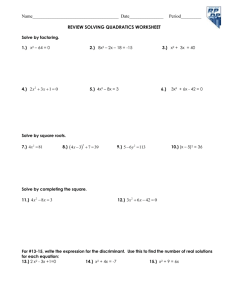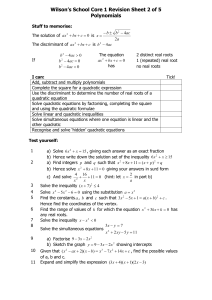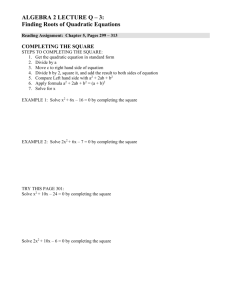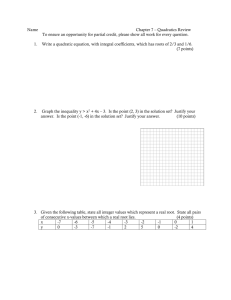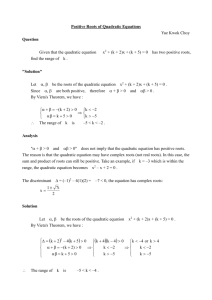Day 6: Using the Quadratic Formula Not all quadratic equations of
advertisement
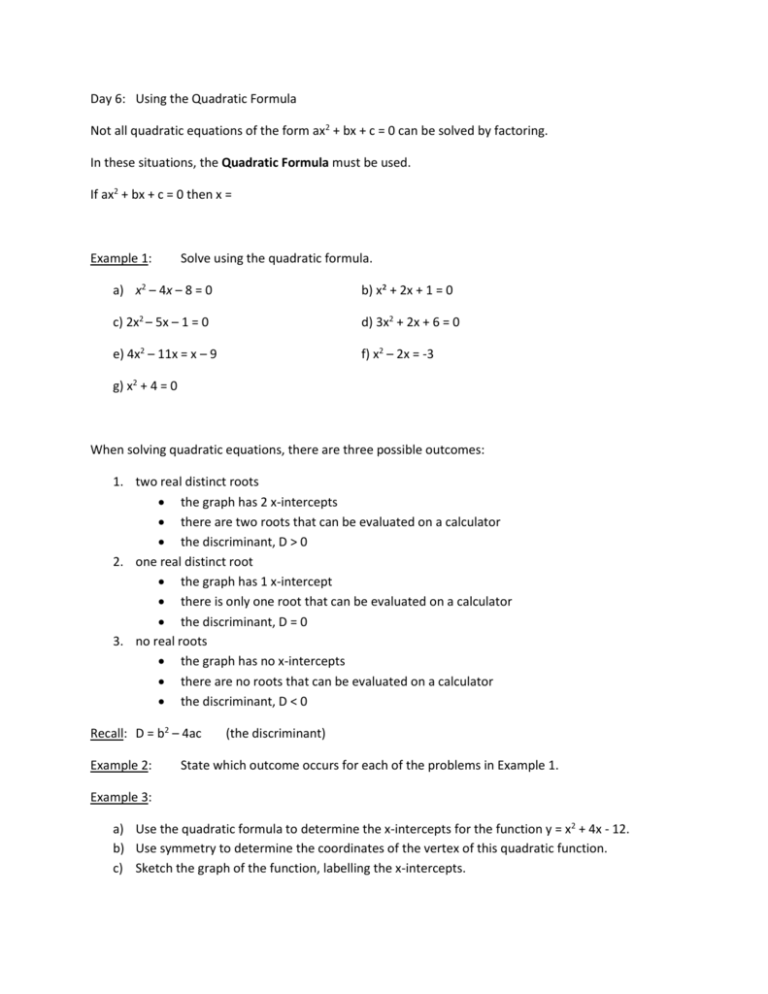
Day 6: Using the Quadratic Formula Not all quadratic equations of the form ax2 + bx + c = 0 can be solved by factoring. In these situations, the Quadratic Formula must be used. If ax2 + bx + c = 0 then x = Example 1: Solve using the quadratic formula. a) x2 – 4x – 8 = 0 b) x² + 2x + 1 = 0 c) 2x2 – 5x – 1 = 0 d) 3x2 + 2x + 6 = 0 e) 4x2 – 11x = x – 9 f) x2 – 2x = -3 g) x2 + 4 = 0 When solving quadratic equations, there are three possible outcomes: 1. two real distinct roots the graph has 2 x-intercepts there are two roots that can be evaluated on a calculator the discriminant, D > 0 2. one real distinct root the graph has 1 x-intercept there is only one root that can be evaluated on a calculator the discriminant, D = 0 3. no real roots the graph has no x-intercepts there are no roots that can be evaluated on a calculator the discriminant, D < 0 Recall: D = b2 – 4ac Example 2: (the discriminant) State which outcome occurs for each of the problems in Example 1. Example 3: a) Use the quadratic formula to determine the x-intercepts for the function y = x2 + 4x - 12. b) Use symmetry to determine the coordinates of the vertex of this quadratic function. c) Sketch the graph of the function, labelling the x-intercepts. Day 6 Homework: 1. Solve using the quadratic formula. Give exact answers. a) 6x2 – 7x – 3 = 0 b) 3x2 + 6x + 1 = 0 c) 2x2 + 6x + 3 = 0 d) 3x2 + 7x + 3 = 0 e) X2 + 6x + 4 = 0 2. Determine the exact values of the x-intercepts of each quadratic function. Then approximate the roots to the nearest hundredth. a) Y = 2x2 + 5x + 1 b) F(x) = x2 – 6x + 7 1 c) G(x) = 2 𝑥 2 +3x + 6 d) H(x) = 3 2 𝑥 -5x 4 +5 3. Use the discriminant to determine the number of roots for each quadratic equation. a) x2 – 3x + 1 = 0 b) 3x2 – 6x + 3 = 0 c) 2x2 – 5x + 7 = 0 d) –x2 + 5.5x + 3.25 = 0 e) 5x2 – 10x + 5 = 0 4. Determine the value(s) of k for which the quadratic equation x2 + kx + 4 = 0 will have each number of roots. a) One distinct real root (two real, equal roots) b) Two distinct read roots c) No real roots 5. The height of a football can be modelled by the function h(t) = -4.9t2 + 21.8t + 1.5, where t is the time, in seconds, since the ball was thrown, and h is the height of the ball, in metres, above the ground. Determine how long the football will be in the air, to the nearest tenth of a second. 3 −1 −3±√6 b) = 𝑥 = 3 3 −5±√17 b) 𝑥 = −3 ± √2 4 −3±√3 2 1. a) x = 2 , x = = c) 𝑥 = 2. a) 𝑥 = c) 𝑥 = 3 ± √21 −7±√13 e) 𝑥 6 10±2√10 d) 𝑥 = 3 d) 𝑥 = = −3 ± √5 3. a) 2 distinct real roots b) 1 distinct real root c) no real roots d) two distinct real roots e) 1 distinct real root 4. a) k = 4, k = -4 b) k > 4 or k < -4 c) -4 < k < 4 5. about 4.5 seconds




